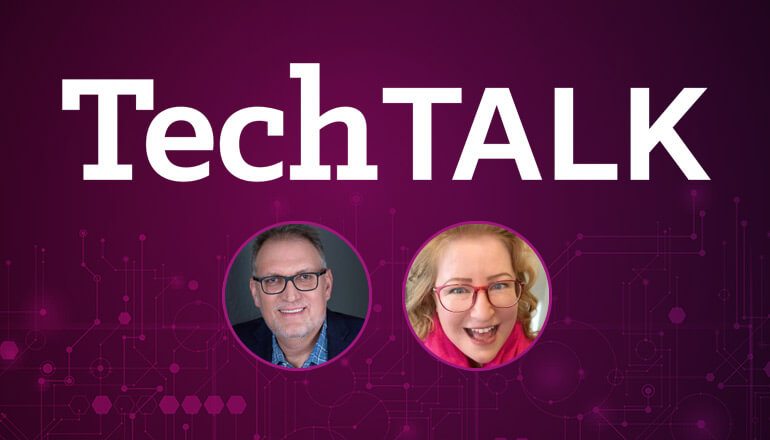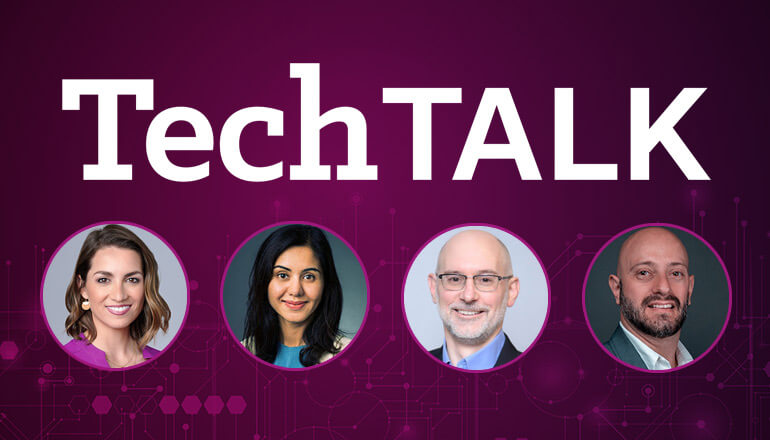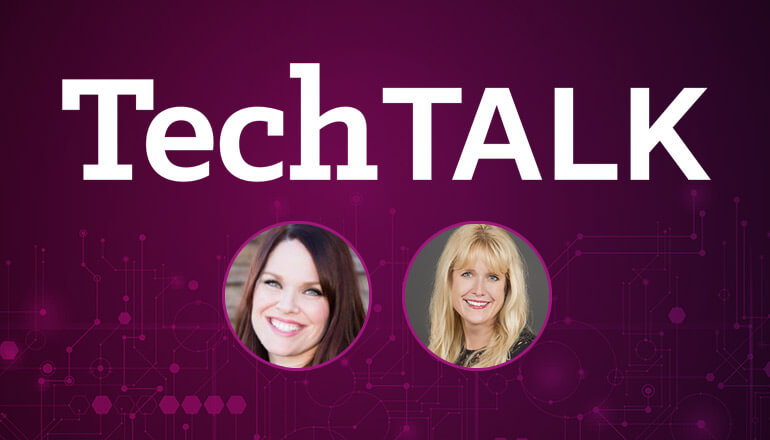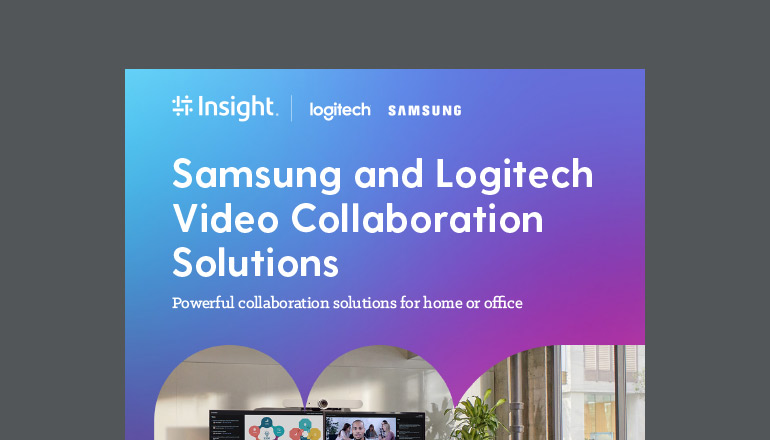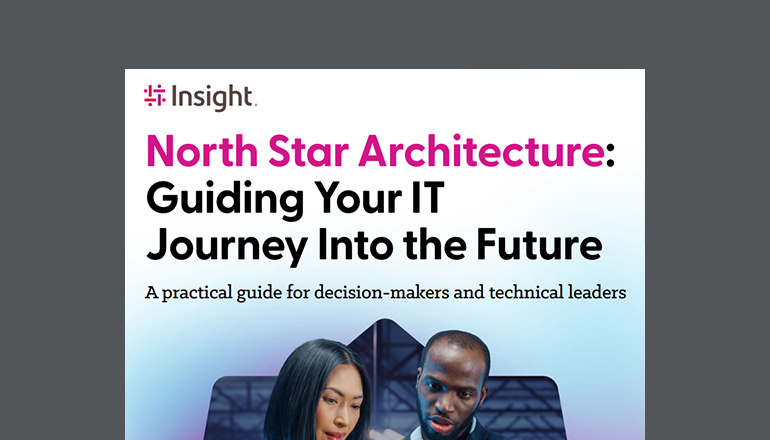Audio transcript:
One Solution to Keep Your Apple Users Productive and Secure
Kate
Hello, thanks for joining us on this insight, Tech Talk, I'm your host, Kate Mayer. Let's talk tech. It's no secret that apple adoption by users in the enterprise space has exponentially grown the past few years. While this growth has many advantages for Apple and its users, it also brings increased risk of digital threats as these popular devices grow in market share. That's why today, more than ever, having an proven apple security and management platform like Jamf is paramount for modern IT organizations. And to tell us more how Jamf helps organizations succeed with apple, we have Jamf's VP of portfolio strategy and longtime digital security guru, Michael Covington. Welcome Michael.
Michael
Thanks for having me.
Kate
Thanks so much for being here today. So let's jump right in. In today's environment of remote and hybrid work, protecting data is so much different, than it was even a couple years ago. How does Jamf stand out in a crowd of security solutions?
Michael
Yeah, there's been so much talk lately about modern work in the modern workplace, and just how different it is from the way people used to, kind of, set up shop in an office. I think fundamentally we're working with different devices, that's one of the starting points. We have a lot of iPhones and tablets that are out there that people are using, probably most often, to get work done. It's primarily because, those are the devices that are always with them. It used to be that you left your device back in the office when you went home or you went on vacation, that's not the case anymore. And it's not just the devices, we've got lots of different ways to connect now, and many of those ways aren't corporate controlled. You've got public Wi-Fi, coffee shops, home offices. even people on the road using cellular. And so all of these new devices, all of this new infrastructure, it's led us to some new use cases. We're more flexible than we were. We're, kind of, blending personal and work in ways that we never did before. And I think we just have access to information and work in a different way. And so we're able to be more productive, and do things differently than we did in the past. When it comes to Jamf, I think we're really, really focused on having proper solutions for hybrid work. Not just thinking about work taking place in a physical office or in a campus, we're really thinking about work that's taking place on all kinds of different-sized devices, and devices of different capabilities. We're also, as you very well know, very, very focused on Apple. We have solutions that really provide that best experience for employees that are interfacing directly with those devices. We also have support that IT appreciates a lot. Things like same day support, adherence to Apple frameworks and standards. We don't use private APIs when we build our solutions. And probably most importantly when it comes to adoption, we're really, really respectful to Apple's commitment to end-user and consumer privacy. We bring that forward into the security solutions that we've brought to market. So that we can coexist with things like iCloud private relay and deliver that great user-experience, that our customers have come to expect.
Kate
Right, that's great.. Thank you. So, sort of, diving in a little bit more. Historically, Apple devices have really been considered secure, right out of the box without the need for other tools or software to keep them safe for users. So what has changed, and you've talked about this a little bit, but what has changed that we should now be looking at security solutions focused on Apple?
Michael
Yeah, and let's be honest upfront here. Apple's done a great job at building a very secure foundation upon which we can build upon. And Apple is gaining more of a footprint in the enterprise, which means they're also more of a target. They've introduced some really interesting things over the last few years. They've introduced capabilities that enable people to bring their own devices to work and use them in a way that doesn't give the organization too much control over that device. It's kind of right-sized management if you will. They've brought out the Apple Silicon, the M1 processors, which I think have been amazing for bringing performance that enterprise users expect. And, you know, realistically, it's not just about what Apple has done to get their devices into the enterprise and therefore, a more of a target for attackers, the landscape has changed. We've really seen a rise in ransomware, so there's more of a need, for not just security education, but good hygiene.
Kate
Right.
Michael
Even Apple updates their operating systems on a fairly regular cadence. And we need to make sure that organizations have the tools in place so that they can make these devices compliant from the start, so, kind of, put good baselines in place.
Kate
Sure.
Michael
But then have the appropriate tools to really do more advanced, next generation threat prevention on these devices. And I think that's what's really making the need for IT to look for built-for Apple security solutions.
Kate
Right, and I think, especially too, you touched on it at the beginning, but Apple is really moving into more of that enterprise space, right. So I'm sure that, you know, requirements, impacts, everything are different as that expands, so.
Michael
Yeah, it's a great point. And I think it's one of the things that we've seen just over the last few years. There's been this trend towards unification.
Kate
Right.
Michael
A lot of IT leaders really want to get as much down into a single console as possible. I think that they're finding that there's gaps in those solutions that were not built for these devices that they're now adopting as part of the modern workplace. And so, they're now starting to surface and say, "No we need same day support for new features, we need at-launch support for new Silicon when it's available in these processors." And when it comes to security, we need efficacy, we need to make sure that we're able to identify Apple malware, just as well as we can identify windows malware, in addition to all the other threats that are hitting these users.
Kate
Right, and I think too, you know, to make it so that it doesn't hinder user experience, right. Which has always been front and center for Apple, and it sounds like Jamf is very committed to that as well. So Jamf has spent the last 20 years evolving into best-in-class Apple device management solutions in the market, and now you're offering Apple first security solutions. So, how has Jamf positioned itself to information and security teams, maybe versus your traditional IT buyer, that you've worked with in the past?
Michael
It's a good question about buying center. And I think it's really important to just start off by saying that security and management, are really best when delivered together. You can have management without security, that's a choice that an organization can make. But you really can't have security without management. And the reason we look at it that way, is that we really try to take a holistic approach to to securing devices and the organizations in which they're used. You need those security capabilities on the device to detect when something is bad, but you also need those management frameworks to remediate, and make sure that when there is something that's gone wrong in the environment, that your user isn't braked. That you can take care of the problem, and get the person back to being productive. And to your point about having a focus on user experience, that is such a core component, of the way we think about delivering security. If you are putting processes and mechanisms in place that make the user want to avoid or circumvent that solution that you've put in place, you've done something wrong. We want users, end-users, to buy into the solutions that are there are in front of them, because they're an important part of the building the defenses that we're trying to put in place.
Kate
That's a really good point. So as a final thought, what advice would you give to security-minded professionals out there, who may be struggling with Apple device management, and patch management. What does the future hold for Jamf that may also help?
Michael
Yeah, when it comes to advice, I think it's really focused on what are your requirements as an organization? And think about how you can achieve those requirements with best of breed solutions. I think there's a lot of solutions that are out there, that try to check a lot of boxes, and they certainly, are able to sit at the table and have a conversation. But when it comes to actually stopping the threat, keeping people productive, and keeping them connected to the applications they need to be connected to for work, they're not doing a very effective job at making the end-user happy with that solution. And as I said earlier, there's really a partnership here between the end-users, the IT pros, that are trying to secure this environment, to make sure that all these tools are kept in place and that people are able to get their work done at the end of the day. So really just kind of keeping that focus there on best-of-breed, but also making sure that that best-of-breed, kind of, set of capabilities is able to fit in with your existing workflows. We're not looking to be the only console that is in the InfoSec team, but we understand how we need to plug into their workflows, that we can help them get their work done faster and not get in the way.
Kate
Yeah, and I think that's it's so critical is that interoperability, right. So that's fantastic. And thank you, Michael, for your insights today. This was a really great conversation, and we really appreciate your time.
Michael
Thanks for having me.
Kate
Yeah, thanks for being here. So you can find more information about Jamf's Apple Enterprise Management and Security Solutions by insight.com/Jamf, or email Jamff@insight.com. Thanks for joining us today.




